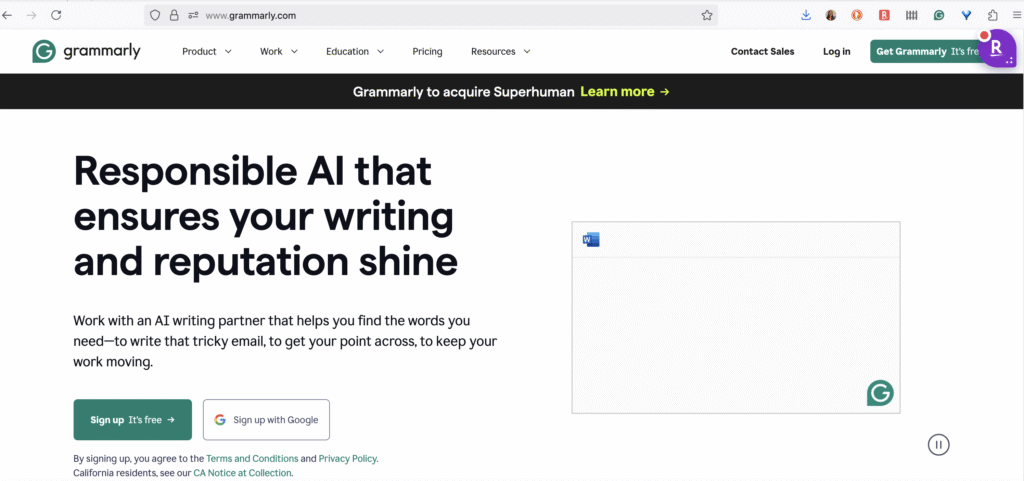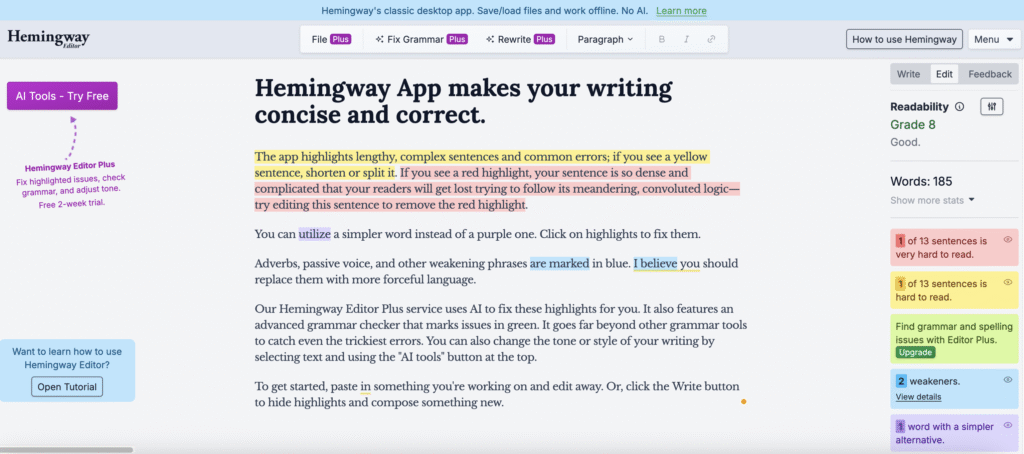Ever read a block of text and felt completely lost? It happens. A lot of writing sounds stiff, formal, and, well, robotic. It’s packed with jargon and complex sentences that make you feel like you need a secret decoder ring just to understand the main point.
But what if you could write in a way that truly connects with people? What if your words could make them feel like they’re having a friendly chat with you over a cup of coffee?
In a world where attention is the most valuable currency, how you say something is just as important as what you say.
A conversational style, with its simple language and direct address, is perfectly designed for this behavior. It grabs attention, pulls readers in, and holds them there.
Let me show you how to adopt a conversational writing style to build trust, boost engagement, and keep your readers hooked from the first sentence to the last.
Contents
What is a Conversational Writing Style?

Conversational writing is a style that mimics the patterns and rhythm of natural, spoken conversation. It’s warm, approachable, and personal.
Think of it as writing for a friend rather than for a panel of judges. The goal is to close the distance between you and your reader, making your message feel less like a lecture and more like a one-on-one dialogue.
This approach isn’t just about sounding friendly; it’s a strategic choice that can have a big impact on how your audience receives your message.
Write the way you talk (but better)
It’s popular advice to “write like you talk.” This is a great starting point, but actually, when you write the way you talk, you should make it clearer and more concise.
When we speak, we often ramble, use filler words (“um,” “like,” “you know”), and jump between ideas. But conversational writing takes the best parts of talking—the natural flow, the simple vocabulary, the personal touch—and edits out the messiness.
It’s a polished version of your spoken voice that keeps the personality, while ensuring the message is direct, organized, and easy to follow. (You’re aiming for the clarity of a great public speaker, not the rambling of a long, unfocused story.)
The difference between a conversational and a formal tone
The easiest way to understand conversational writing is to see it next to its opposite: formal writing. Formal writing is what you see in academic papers, legal documents, or traditional corporate reports. It’s impersonal, objective, and often complex.
A few examples:
| Formal Tone | Conversational Tone |
| The organization will implement a new strategy to enhance customer satisfaction. | We’re rolling out a new plan to make you, our customers, happier. |
| All employees are required to complete the mandatory training by the specified deadline. | Hey team, please make sure you finish the required training by the deadline. |
| Further investigation is needed to ascertain the cause of the discrepancy. | We need to look into what caused this issue. |
| It has been determined by management that remote work will be permitted on Fridays. | Good news! We’ve decided you can work from home on Fridays. |
See the difference? The conversational examples are direct, use personal pronouns, and feature simpler words. They feel more human and are much easier to understand at a glance.
How a conversational style builds trust with your audience
Trust is the foundation of any good relationship, which includes the one between you and your audience. A conversational tone helps build that trust by making your brand or message feel more authentic and relatable.
When you write in a stiff, corporate voice, you create a barrier. It can feel like you’re hiding behind a wall of formality. In contrast, a conversational voice feels open and honest. It signals that there’s a real person behind the words.
A brand voice that is authentic and consistent helps build customer trust and loyalty over time because it makes the brand more memorable and reliable (Gaidar, 2023). People trust what they can understand and who they feel connected to. By ditching the corporate-speak, you’re telling your readers, “We’re on the same level, and we want to help you.”
How it improves clarity and readability

Source: Styled Stock Society
Have you ever tried to assemble furniture using a poorly written instruction manual? It’s frustrating because it’s not clear.
Conversational writing is all about clarity. It prioritizes simple language, active voice, and shorter sentences—all elements that make your text easier to read and understand.
This isn’t just a matter of preference; it’s about how our brains process information. When text is easy to read, it lowers the “cognitive load,” meaning your reader doesn’t have to work as hard to get the message. This makes them more likely to stay on the page and absorb what you’re saying.
Plain language is for everyone—even experts—because all users appreciate content that is clear, concise, and easy to understand.
Now that you understand what conversational writing is and why it’s so effective, let’s get into the practical side of things. How do you do it?
Simple Tricks to Write in a Conversational Tone
Adopting a conversational tone isn’t about changing who you are; it’s about letting more of your natural voice shine through in your writing. Here are some simple, powerful techniques you can start using right now.
Use the first and second person (“we,” “I,” and “you”)
This is the fastest way to make your writing feel like a dialogue.
- “You” and “Your”: These words speak directly to the reader, making them feel seen and included. It changes the experience from passive observation to active participation. Instead of “A user can benefit from this feature,” you’d write, “You can benefit from this feature.”
- “I” and “We”: These pronouns establish your presence in the conversation. “I” adds a personal touch and shows you’re sharing your own perspective. “We” creates a sense of community and shared purpose, making the reader feel like they’re part of a team.
Write with simple words and avoid jargon

Imagine you’re explaining a topic to a friend who knows nothing about it. You wouldn’t use technical jargon or complicated vocabulary, would you? You’d use simple, everyday words. Do the same in your writing.
Industry-specific terms can make you sound smart to your peers, but they alienate everyone else. If you absolutely must use a technical term, take a moment to explain it in simple language.
For example:
- Instead of: “We must leverage our core competencies to synergize our cross-functional teams.”
- Try: “We need to use our team’s main strengths to work together more effectively.”
Clarity always wins over complexity.
Use contractions like “you’re,” “it’s,” and “don’t”
In spoken conversation, we naturally use contractions. We say “don’t” instead of “do not” and “it’s” instead of “it is.” Using them in your writing is a simple cue that tells the reader your tone is informal and friendly.
For a long time, formal writing guides advised against contractions, but for modern web content, they are essential for creating a natural, conversational flow. Omitting them can make your writing sound stiff and overly formal.
Ask your reader direct questions

Have you noticed how questions are used in this article? Questions are a powerful tool for engagement. They break up the text, create a mental pause for the reader, and encourage them to think about the topic in a personal way.
You can use questions to:
- Introduce a new section.
- Check for understanding (“Make sense?”).
- Encourage reflection (“What would you do in this situation?”).
- Make a point more impactful.
Asking questions turns a monologue into a dialogue, even if the reader’s answer is only in their head.
Keep your sentences and paragraphs short
When you talk, you naturally pause for breath. Short sentences and paragraphs create a similar rhythm in your writing. They serve as visual and mental resting spots for your reader.
Long walls of text are intimidating, especially on a screen. Here’s a good rule of thumb:
- Sentences: Aim for an average of 15 to 20 words. Mix it up with some very short sentences for emphasis. Like this.
- Paragraphs: Try to keep paragraphs to 3 to 4 sentences. A one-sentence paragraph can also be very effective for highlighting a key idea.
This structure makes your content more scannable and much less overwhelming for your audience.
Tell a story or use a good analogy

Humans are wired for stories. We’ve been using them to share information and connect with each other for thousands of years. A well-placed story or analogy can make even the most complex topic relatable and memorable.
Neuroeconomist Paul J. Zak’s research, featured in Harvard Business Review, shows that our brains release oxytocin—a chemical associated with empathy—when we are engaged in a compelling narrative. This neurochemical response makes us more likely to trust the storyteller and internalize the message.
- Instead of: “Our software improves efficiency by 30%.”
- Try: “Meet Sarah. She used to spend 10 hours a week on manual data entry. After switching to our software, she now gets the same work done in 7 hours, giving her more time to focus on what really matters.”
Stories stick with people long after they’ve forgotten the statistics.
Once you’ve written your draft using these techniques, the most important step comes next. It’s a simple action that can make the biggest difference in your writing.
Read Your Copy Aloud to Find Awkward Phrasing

This might be the single most effective editing trick in a writer’s toolkit. When you read your work aloud, you engage a different part of your brain. You’re not just seeing the words; you’re hearing them. This process reveals awkward phrasing, clunky sentences, and unnatural rhythms that your eyes might have skimmed over.
Why your ear catches what your eye misses
When you read silently, your brain is incredibly efficient. It often autocorrects small mistakes, fills in missing words, and glides over slightly awkward sentences without you even noticing. You read what you intended to write, not necessarily what’s on the page.
However, when you speak the words, that shortcut is gone. You are forced to process each word and sentence structure exactly as it is. Your ear, trained from years of listening to conversations, is a natural detector for what sounds human and what sounds robotic. If it sounds weird when you say it, it will definitely feel weird for your audience to read it.
How to spot clunky sentences and unnatural words
As you read your text aloud, listen for specific red flags:
- Sentences where you run out of breath: This is a clear sign the sentence is too long or convoluted.
- Words that make you stumble: If you have trouble pronouncing a word, it’s probably too complex. Swap it for a simpler alternative.
- Clumsy or repetitive rhythms: Does every sentence sound the same? Do you use the same word too many times in one paragraph? Your ear will pick up on this monotony.
- Phrases that just don’t sound like something a real person would say: If you find yourself thinking, “I would never say this in a real conversation,” that’s your cue to rewrite it.
A step-by-step process for an “out loud” edit

To get the most out of this technique, follow a simple process:
- Find a quiet space. You need to be able to hear yourself clearly without distractions.
- Read at a natural pace. Don’t rush. Speak the words as if you were having a conversation.
- Use a pen or your cursor. As you read, mark or highlight any part that feels awkward, clunky, or confusing. Don’t stop to fix it yet—just mark it and keep going to maintain the flow.
- Review your notes. Once you’ve finished reading, go back to the parts you highlighted. Now is the time to edit.
- Read it aloud again. After making your changes, do one final read-aloud to make sure the new version flows smoothly.
What to do when you find an awkward phrase
When you hit a stumbling block, don’t panic. The fix is usually straightforward.
- If a sentence is too long, break it into two or three shorter sentences.
- If a word is too complex, find a simpler synonym. (Use an online thesaurus to find them.)
- If the phrasing is unnatural, ask yourself, “How would I say this to a friend?” Then write that down. Often, the most natural-sounding fix is the one that comes to mind first.
While your own ear is your best tool, you don’t have to go it alone. Technology can offer a helpful second opinion.
Tools That Help Your Conversational Tone
Modern writing tools can act as a great co-pilot, helping you spot issues and refine your tone. They can analyze your text in seconds and provide data-driven suggestions to make your writing more conversational and accessible.
Use a readability score checker

Readability scores measure how easy your text is to understand. The most common one is the Flesch-Kincaid Grade Level. This score estimates the U.S. school grade level required to comprehend the text. For most web content, the best practice is to aim for a maximum 7th- or 8th-grade reading level.
Many platforms, like WordPress with the Yoast SEO plugin, have built-in readability checkers. You can also use free online tools where you simply paste your text to get a score.
How apps like Hemingway help simplify your text
The Hemingway App is a fantastic tool specifically designed to make your writing bold and clear. It doesn’t just check for spelling and grammar; it highlights common problem areas that hurt readability:
- Sentences that are hard to read: It flags long, complex sentences in yellow.
- Sentences that are very hard to read: These get highlighted in red.
- Use of passive voice: It points out instances of passive voice, which can make your writing weaker and less direct.
- Complex words: It suggests simpler alternatives for multisyllable words.
- Adverbs: It helps you cut down on weak adverbs.
Using Hemingway is like having a tough but fair editor looking over your shoulder, constantly pushing you to be more direct and clear.
The benefit of grammar tools for flow and clarity

Tools like Grammarly have also evolved beyond simple spell-checking. The premium versions now offer sophisticated suggestions for tone, clarity, and fluency. Grammarly can detect if your tone sounds formal, confident, or friendly, and it will offer changes to better match your intended voice.
It can also help you rewrite wordy sentences to be more concise and rephrase passages that might be unclear to the reader. These AI-powered suggestions can be incredibly helpful for catching subtle issues and ensuring your conversational style is consistent throughout your piece.
A conversational tone is powerful, but like any tool, it can be misused. To keep your writing effective and professional, you need to be aware of the common pitfalls.
Common Mistakes in Conversational Writing
Writing conversationally doesn’t mean abandoning all the rules. The goal is to be clear, engaging, and professional—not sloppy. Here are a few common mistakes to watch out for.
Overusing slang and emojis

While a well-placed emoji or a bit of modern slang can add personality, it’s easy to overdo it. The key is to know your audience. A blog post for Gen Z marketers might benefit from a 🔥 or a bit of slang, but the same approach would likely fall flat in a report for C-suite executives.
Overusing these elements can make your writing seem unprofessional or, even worse, like you’re trying too hard. Use them sparingly and only when you’re confident they match your audience’s expectations and your brand’s voice.
Mismatching the tone to your brand voice
Your conversational style should always align with your overall brand identity. Is your brand playful and witty? Or is it more helpful and reassuring? Your tone should be a reflection of that personality.
A consistent brand voice is essential for building brand recognition and fostering customer loyalty. When customers can reliably predict a brand’s personality through its voice, it builds a stronger, more trusting relationship.
If your website’s homepage is formal and corporate, but your blog is suddenly filled with casual banter, that inconsistency can be jarring for your audience. Make sure your conversational efforts feel authentic to your brand.
Forgetting basic grammar and spelling rules

Conversational does not mean careless. Proper grammar, spelling, and punctuation are still essential for credibility. Errors can make your writing look unprofessional and distract the reader from your message.
While you can bend some rules (like starting a sentence with “And” or “But”), the fundamentals still matter. Always proofread your work or use a grammar tool to catch any mistakes before you publish. A clean, error-free copy shows respect for your reader’s time and attention.
Using filler words
Filler words are the verbal clutter of writing. They sneak into sentences and add length without adding any meaning. They weaken your message and make you sound less confident.
Here are some common filler words to watch out for and cut:
- Just
- Really
- Very
- Actually
- Basically
- In order to (just use “to”)
- That (often unnecessary, e.g., “He said that he was going” vs. “He said he was going”)
Many filler words are adverbs (words that end with “-ly”).
Be ruthless in your editing. If a word doesn’t add value, delete it. Your writing will be stronger and more direct as a result.
Wrap Up
Mastering conversational writing doesn’t happen overnight, but it’s a skill that pays off in every piece of content you create. By using simple language, writing directly to your reader with “you,” and telling stories, you can make your work more relatable, engaging, and effective.
But if you take only one thing away from this guide: read your work aloud. It’s the most powerful tool you have for bridging the gap between the words on the screen and the human voice you want your audience to hear. It’s simplest and fastest way to ensure your message sounds natural, clear, and, most importantly, human.
Try one or two of these tips in your next email, LinkedIn article or blog post. You’ll be surprised at how a friendly, conversational tone can help you connect with your audience on a much deeper level.
References
Loranger, H. (2017). Plain Language Is for Everyone, Even Experts. Nielsen Norman Group. Retrieved from https://www.nngroup.com/articles/plain-language-experts/
Zak, P. J. (2014). Why Your Brain Loves Good Storytelling. Harvard Business Review. Retrieved from https://hbr.org/2014/10/why-your-brain-loves-good-storytelling














